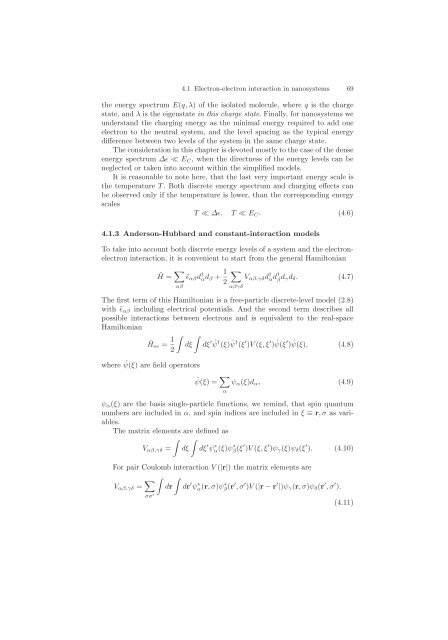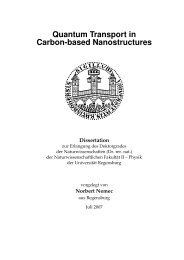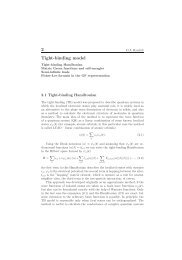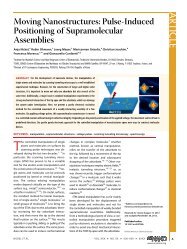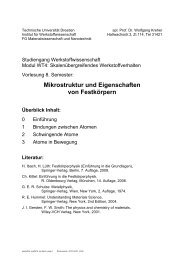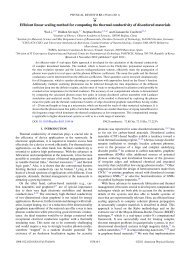4 Coulomb blockade
4 Coulomb blockade
4 Coulomb blockade
Create successful ePaper yourself
Turn your PDF publications into a flip-book with our unique Google optimized e-Paper software.
4.1 Electron-electron interaction in nanosystems 69<br />
the energy spectrum E(q, λ) of the isolated molecule, where q is the charge<br />
state, and λ is the eigenstate in this charge state. Finally, for nanosystems we<br />
understand the charging energy as the minimal energy required to add one<br />
electron to the neutral system, and the level spacing as the typical energy<br />
difference between two levels of the system in the same charge state.<br />
The consideration in this chapter is devoted mostly to the case of the dense<br />
energy spectrum ∆ɛ ≪ EC, when the directness of the energy levels can be<br />
neglected or taken into account within the simplified models.<br />
It is reasonable to note here, that the last very important energy scale is<br />
the temperature T . Both discrete energy spectrum and charging effects can<br />
be observed only if the temperature is lower, than the corresponding energy<br />
scales<br />
T ≪ ∆ɛ, T ≪ EC. (4.6)<br />
4.1.3 Anderson-Hubbard and constant-interaction models<br />
To take into account both discrete energy levels of a system and the electronelectron<br />
interaction, it is convenient to start from the general Hamiltonian<br />
ˆH = <br />
αβ<br />
˜ɛαβd † αdβ + 1<br />
2<br />
<br />
αβγδ<br />
Vαβ,γδd † αd †<br />
β dγdδ. (4.7)<br />
The first term of this Hamiltonian is a free-particle discrete-level model (2.8)<br />
with ˜ɛαβ including electrical potentials. And the second term describes all<br />
possible interactions between electrons and is equivalent to the real-space<br />
Hamiltonian<br />
ˆHee = 1<br />
<br />
2<br />
<br />
dξ<br />
where ˆ ψ(ξ) are field operators<br />
dξ ′ ˆ ψ † (ξ) ˆ ψ † (ξ ′ )V (ξ,ξ ′ ) ˆ ψ(ξ ′ ) ˆ ψ(ξ), (4.8)<br />
ˆψ(ξ) = <br />
ψα(ξ)dα, (4.9)<br />
α<br />
ψα(ξ) are the basis single-particle functions, we remind, that spin quantum<br />
numbers are included in α, and spin indices are included in ξ ≡ r,σ as variables.<br />
The matrix elements are defined as<br />
<br />
Vαβ,γδ = dξ dξ ′ ψ ∗ α(ξ)ψ ∗ β(ξ ′ )V (ξ,ξ ′ )ψγ(ξ)ψδ(ξ ′ ). (4.10)<br />
For pair <strong>Coulomb</strong> interaction V (|r|) the matrix elements are<br />
Vαβ,γδ = <br />
<br />
dr<br />
σσ ′<br />
dr ′ ψ ∗ α(r,σ)ψ ∗ β(r ′ ,σ ′ )V (|r − r ′ |)ψγ(r,σ)ψδ(r ′ ,σ ′ ).<br />
(4.11)


